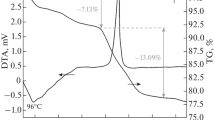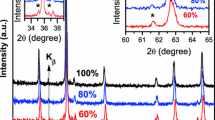Abstract
The ferrite compositions of NixZnxFe2O4 were synthesized by self-propagating high temperature synthesis reaction with various contents of iron, iron oxide, nickel oxide and zinc oxide at oxygen partial pressures varying between 0.05 to 5.0 MPa. The oxygen pressure promoted the combustion reaction, while the compacting pressure retarded the reaction. The rate equation of ferrite formation is shown to be v = 14.5 exp (Tc1380 - 1) P 0.2O2 . Phase identification of the final products by X-ray diffraction (XRD) revealed that the enhanced combustion reaction with oxygen pressure and iron content in the reactants resulted in increasing the spinel content in the combustion product. As the oxygen pressure changed from 0.1 to 5 MPa, the coercive force and residual magnetization decreased by about 73% and 66%, respectively, whereas, the maximum magnetization, susceptibility and Curie temperature increased by about 70%, 60%, and 32%, respectively. The improved magnetic properties are accounted for by the enhanced iron oxidation at a given combustion condition. Compared to the magnetic properties and productivity of the Ni-Zn ferrites prepared by wet chemical method, the self-propagating high temperature synthesis method at high oxygen pressure is one of the useful methods to fabricate improved ferrite powders.
Similar content being viewed by others
References
A. M. ABDEN, J. Magn. Magn. Mater. 185 (1998) 199.
A. DIAS and V. T. L. BUONO, J. Mater. Res. 12 (1997) 3278.
D. G. INORG. Synth. 63 (1967) 152.
T. T. SRINIVASAN and P. RAVINDRANATHAN, J. Appl. Phy. 31 (1988) 3789.
F. J. SCHNETTLER and D. W. JOHNSON, in “Synthetic Microstructure in Ferrite” (Tokyo Press, 1971) p. 121.
P. B. AVAKYAN, E. L. NERSIZYAN, M. D. NERSESY, V. G. ANDREE and A. M. SALDAGUEI, Int. J. SHS 5 (1996) 241.
A. G. MERZHANOV, Vestn. Akad. Nauk SSSR 10 (1976) 76.
Z. A. MUNIR, Cerarm Bull. 67 (1988) 342.
K. SURESH, N. R. S. KUMAR and K. C. PATIL, Adv. Mater. 3 (1991) 148.
Y. CHOI et al., J. Mater. Sci. Lett., accepted July 1998.
Y. CHOI, N. I. CHO and Y. D. HAHN, Korean J. Magn. Mater. accepted January 1999.
HIRANO, Y. MIYAMOTO and M. KOIZUMI, Adv. Ceram. Mater. 2 (1987) 790.
S. LOWELL and J. E. SHIELDS, in “Powder Surface Area and Porosity” (Chapman and Hall Ltd., New York, 1987) p. 306.
K. TATANI, K. KOIZUMI, F. S. HOWELL, A. KISHIOKA and M. KINOSHITA, J. Mater. Sci. 23 (1988) 3405.
W. F. PONG, M. H. SUH and C. T. CHEN, Phys. Rev. B 16 (1996) 641.
Z. QIAN, G. WANG, J. M. SIVERTSEN and J. H. JUDY, IEEE Trans. Magn. 33 (1997) 3748.
K. G. SHKADINSKY, G. V. SHKADINSKAYA, B. J. MATKOWSKY and V. A. VOLPERT, Int. J. SHS 1 (1992) 371.
W. F. PONG, Y. K. CHANG, M. H. SU and P. K. TSENG, Phy. Rev. B 55 (1997) 409.
P. S. KUMER, J. J. SHROT I, C. E. DESHPANDE and S. K. DATE, J. Appl. Phys. 81 (1997) 4788.
Author information
Authors and Affiliations
Rights and permissions
About this article
Cite this article
Choi, Y., Cho, N.I., Kim, H.C. et al. Magnetic properties of Ni-Zn ferrite powders formed by self-propagating high temperature synthesis reaction. Journal of Materials Science: Materials in Electronics 11, 25–30 (2000). https://doi.org/10.1023/A:1008900119210
Issue Date:
DOI: https://doi.org/10.1023/A:1008900119210




